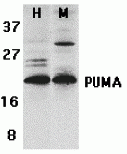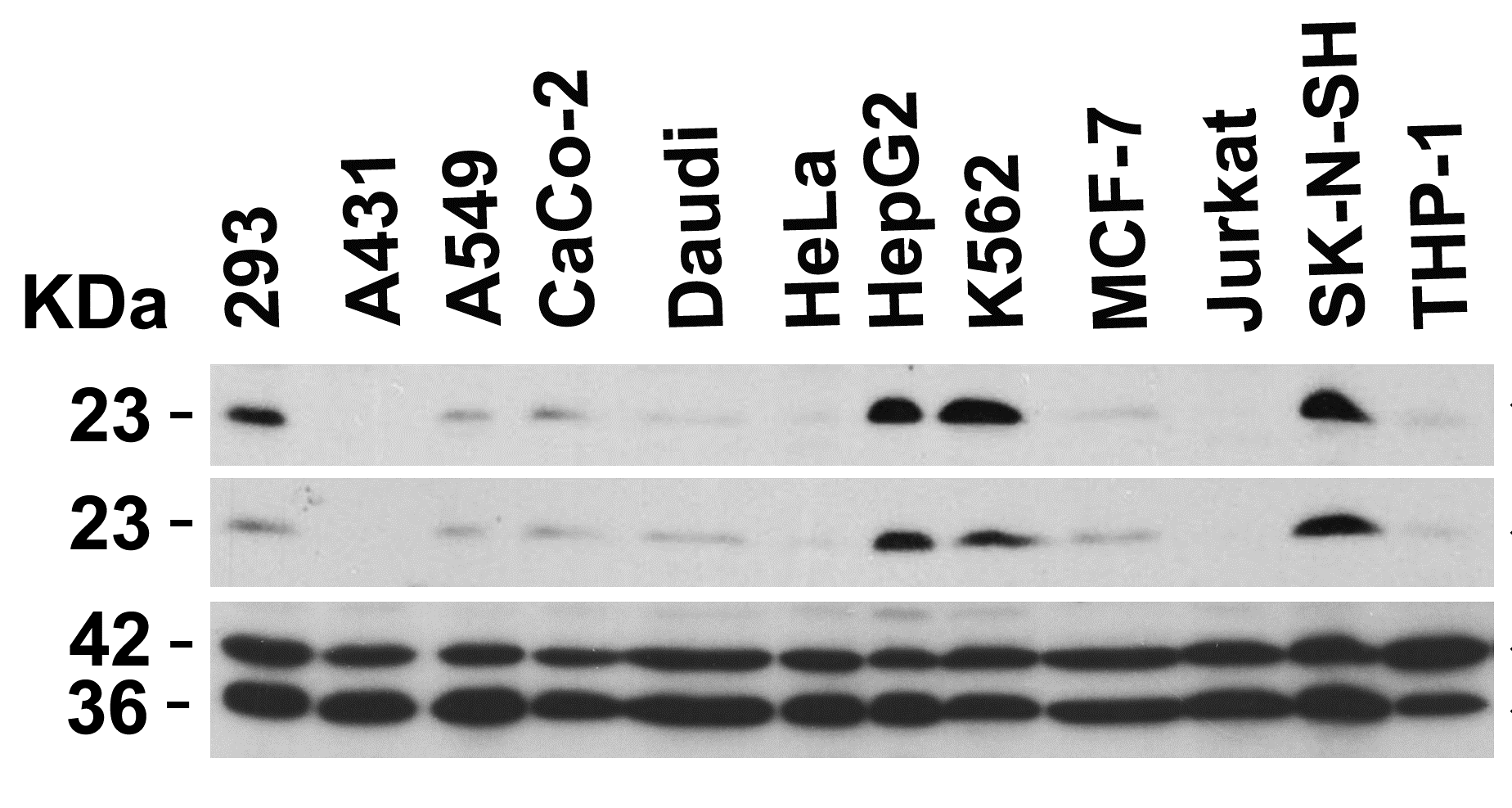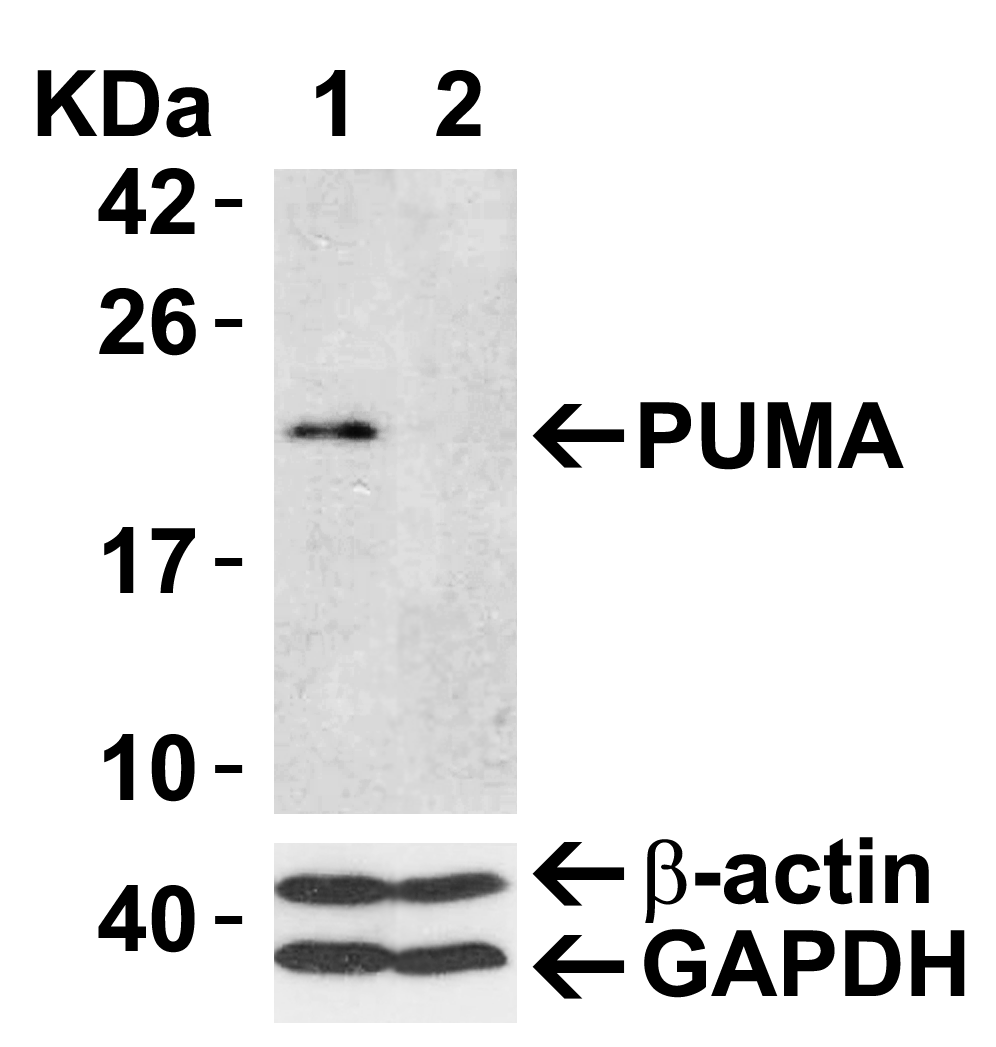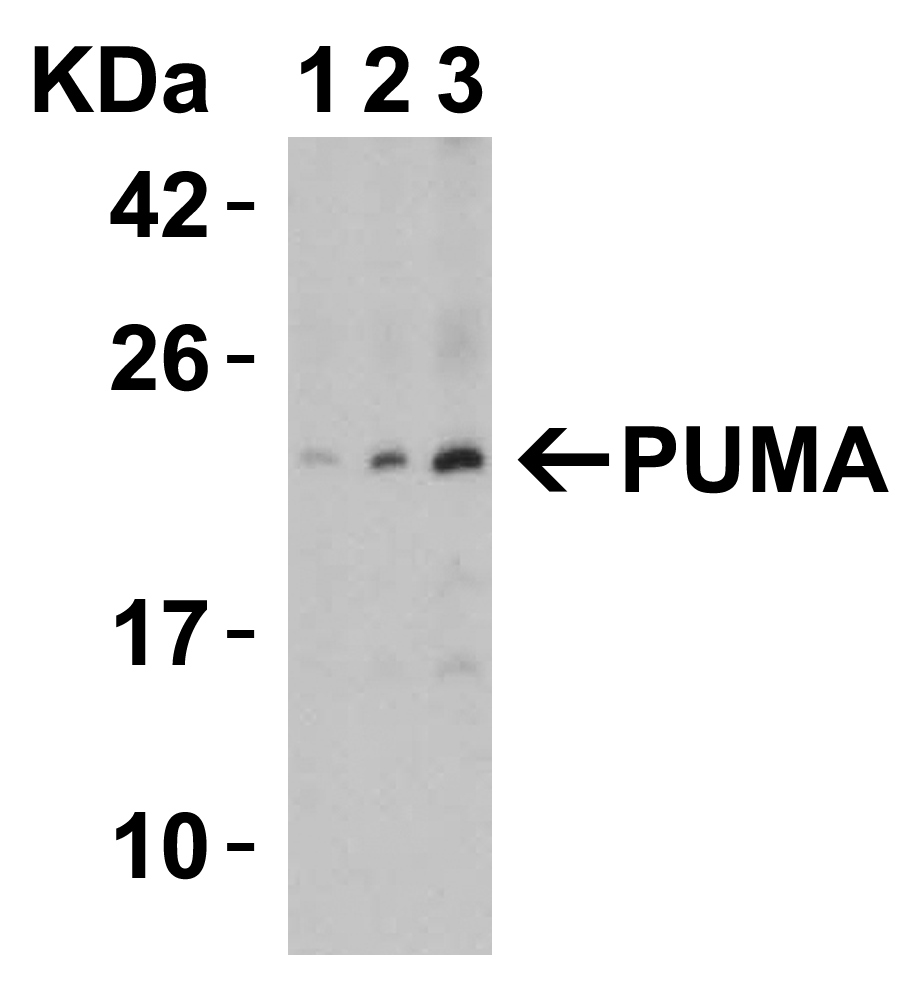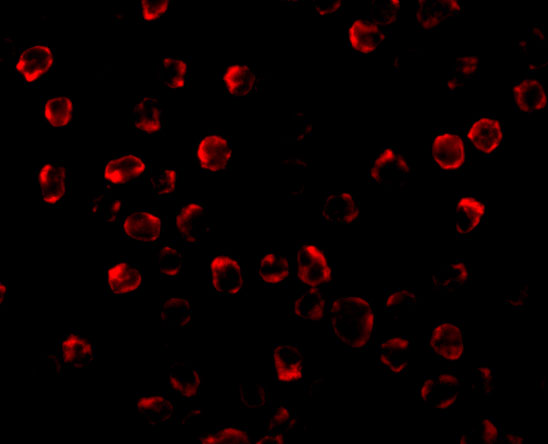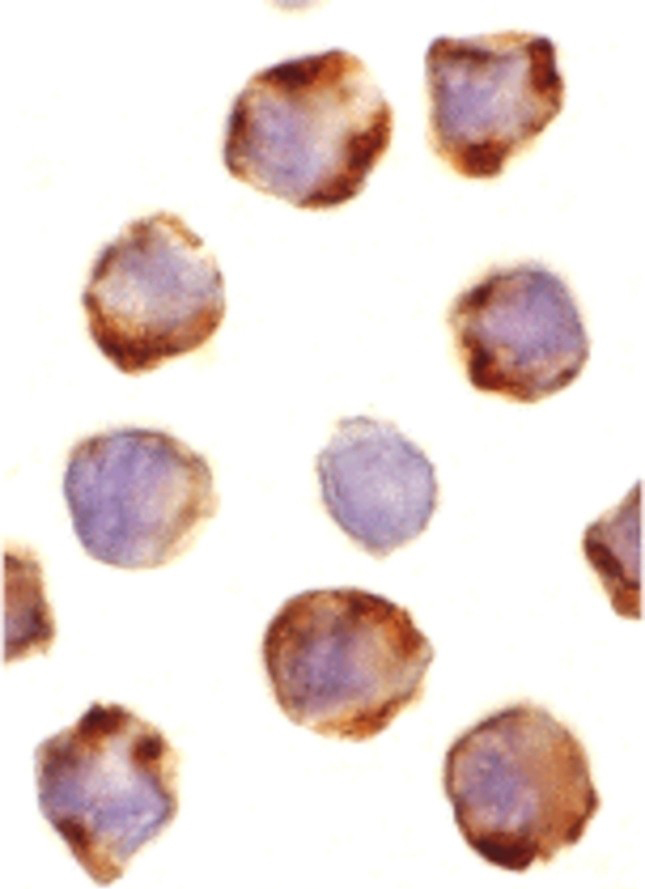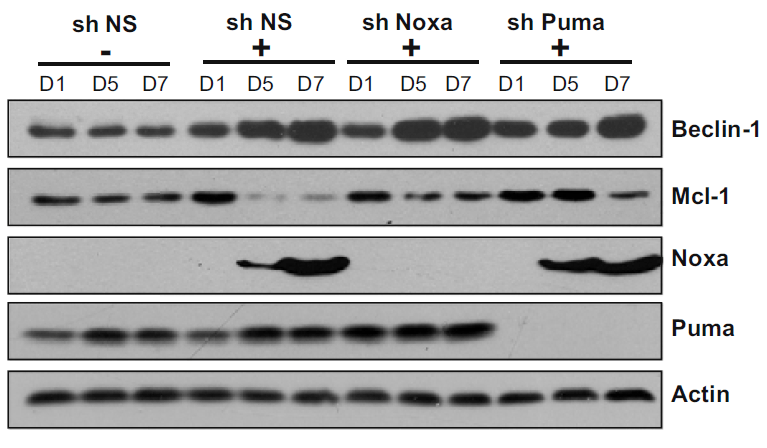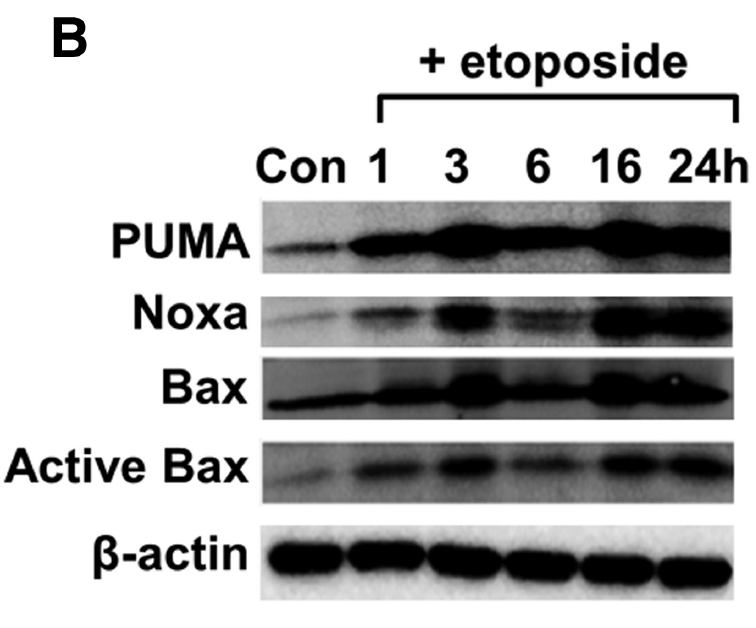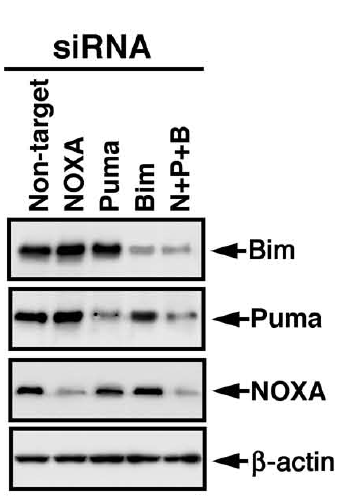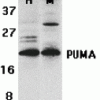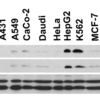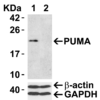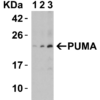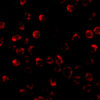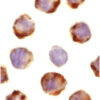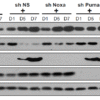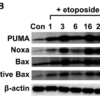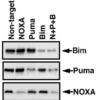Anti-PUMA (CT) Antibody (11007)
$445.00
SKU: 11007
Categories: Antibody Products, Apoptosis Antibodies, Products
Overview
Product Name Anti-PUMA (CT) Antibody (11007)
Description Anti-PUMA (CT) Rabbit Polyclonal Antibody
Target PUMA (CT)
Species Reactivity Human, Mouse
Applications ELISA,WB,ICC,IF
Host Rabbit
Clonality Polyclonal
Isotype IgG
Immunogen Synthetic peptide corresponding to aa 180-193 of human PUMA-a (accession no NP_055232). This sequence is identical in human PUMA-a and PUMA-b.
Properties
Form Liquid
Concentration Lot Specific
Formulation PBS, pH 7.4.
Buffer Formulation Phosphate Buffered Saline
Buffer pH pH 7.4
Format Purified
Purification Purified by peptide immuno-affinity chromatography
Specificity Information
Specificity This antibody recognizes human and mouse PUMA (23kDa). A lower molecular weight band at 16kDa is detected in MOLT4 and U937 cell lysates and probably represents the PUMA-β protein.
Target Name Bcl-2-binding component 3, isoforms 1/2
Target ID PUMA (CT)
Uniprot ID Q9BXH1
Alternative Names JFY-1, p53 up-regulated modulator of apoptosis
Gene Name BBC3
Gene ID 27113
Accession Number NP_055232
Sequence Location Mitochondrion
Biological Function Essential mediator of p53/TP53-dependent and p53/TP53-independent apoptosis (PubMed:11463391, PubMed:23340338). Promotes partial unfolding of BCL2L1 and dissociation of BCL2L1 from p53/TP53, releasing the bound p53/TP53 to induce apoptosis (PubMed:23340338). Regulates ER stress-induced neuronal apoptosis (By similarity). {UniProtKB:Q99ML1, PubMed:11463391, PubMed:23340338}.
Research Areas Apoptosis
Background PUMA (p53 Upregulated Modulator of Apoptosis) is a pro-apoptotic Bcl-2 family member that encodes two BH3 domain- containing proteins, PUMA-alpha and PUMA-beta. PUMA proteins bind Bcl-2, localize to mitochondria, and induce cytochrome c release and apoptosis in response to p53.
Application Images










Description Western Blot Validation of PUMA in K562 and 3T3/NIH Cells
Loading: 15 ug of lysates per lane. Antibodies: 11007 (2 ug/mL), 1 h incubation at RT in 5% NFDM/TBST.Secondary: Goat anti-rabbit IgG HRP conjugate at 1:10000 dilution.
Loading: 15 ug of lysates per lane. Antibodies: 11007 (2 ug/mL), 1 h incubation at RT in 5% NFDM/TBST.Secondary: Goat anti-rabbit IgG HRP conjugate at 1:10000 dilution.

Description Independent Antibody Validation (IAV) via Protein Expression Profile in Cell Lines
Loading: 20 ug of lysates per lane. Antibodies: 11007 (3 ug/mL), 11008 (2 ug/mL), beta-actin (1 ug/mL) and GAPDH (0.02 ug/mL), 1 h incubation at RT in 5% NFDM/TBST.Secondary: Goat anti-rabbit IgG HRP conjugate at 1:10000 dilution.
Loading: 20 ug of lysates per lane. Antibodies: 11007 (3 ug/mL), 11008 (2 ug/mL), beta-actin (1 ug/mL) and GAPDH (0.02 ug/mL), 1 h incubation at RT in 5% NFDM/TBST.Secondary: Goat anti-rabbit IgG HRP conjugate at 1:10000 dilution.

Description Validation with PUMA siRNA Knockdown in 293 Cells
293 cells were transfected with control siRNAs (lane 1) or PUMA siRNAs (lane 2) Loading: 15 ug of 293 whole cell lysates per lane. Antibodies: 11007 (2 ug/mL), beta-actin (1 ug/mL) and GAPDH (0.02 ug/mL), 1 h incubation at RT in 5% NFDM/TBST.Secondary: Goat anti-rabbit IgG HRP conjugate at 1:10000 dilution.
293 cells were transfected with control siRNAs (lane 1) or PUMA siRNAs (lane 2) Loading: 15 ug of 293 whole cell lysates per lane. Antibodies: 11007 (2 ug/mL), beta-actin (1 ug/mL) and GAPDH (0.02 ug/mL), 1 h incubation at RT in 5% NFDM/TBST.Secondary: Goat anti-rabbit IgG HRP conjugate at 1:10000 dilution.

Description Sensitivity Test for PUMA in 2983 Cells
Loading: Lysates/proteins at 15 ug per lane. Antibodies: 11007 (lane 1-3: 1, 2 and 4 ug/mL). 1 h incubation at RT in 5% NFDM/TBST.Secondary: Goat anti-rabbit IgG HRP conjugate at 1:10000 dilution.
Loading: Lysates/proteins at 15 ug per lane. Antibodies: 11007 (lane 1-3: 1, 2 and 4 ug/mL). 1 h incubation at RT in 5% NFDM/TBST.Secondary: Goat anti-rabbit IgG HRP conjugate at 1:10000 dilution.

Description Immunofluorescence Validation of PUMA in K562 Cells
Immunofluorescent analysis of 4% paraformaldehyde-fixed K562 cells labeling PUMA with 11007 at 2 ug/mL, followed by goat anti-rabbit IgG secondary antibody at 1/500 dilution (red). Image showing cytosol staining on K562 cells.
Immunofluorescent analysis of 4% paraformaldehyde-fixed K562 cells labeling PUMA with 11007 at 2 ug/mL, followed by goat anti-rabbit IgG secondary antibody at 1/500 dilution (red). Image showing cytosol staining on K562 cells.

Description Immunocytochemistry Validation of PUMA in K562 Cells
Immunocytochemical analysis of K562 cells using anti-PUMA antibody (11007) at 1 ug/ml. Cells was fixed with formaldehyde and blocked with 10% serum for 1 h at RT; antigen retrieval was by heat mediation with a citrate buffer (pH6). Samples were incubated with primary antibody overnight at 4C. A goat anti-rabbit IgG H&L (HRP) at 1/250 was used as secondary. Counter stained with Hematoxylin.
Immunocytochemical analysis of K562 cells using anti-PUMA antibody (11007) at 1 ug/ml. Cells was fixed with formaldehyde and blocked with 10% serum for 1 h at RT; antigen retrieval was by heat mediation with a citrate buffer (pH6). Samples were incubated with primary antibody overnight at 4C. A goat anti-rabbit IgG H&L (HRP) at 1/250 was used as secondary. Counter stained with Hematoxylin.

Description KD Validation of PUMA in HOSE-RasV12 Cells (Elgendy et al., 2011)
HOSE-RasV12 cells were transfected with control shRNA plasmid or shRNA plasmids (KD) targeted against Noxa or Puma, as indicated. PUMA expression was not observed in PUMA KD cells detected by anti-PUMA antibodies (11007).
HOSE-RasV12 cells were transfected with control shRNA plasmid or shRNA plasmids (KD) targeted against Noxa or Puma, as indicated. PUMA expression was not observed in PUMA KD cells detected by anti-PUMA antibodies (11007).

Description Induction Validation of PUMA in Primary Cortical Neurons (Sabirzhanov et al., 2014)
PUMA protein levels were increased in etoposide-treated primary cortical neurons detected by anti-PUMA antibodies (11007).
PUMA protein levels were increased in etoposide-treated primary cortical neurons detected by anti-PUMA antibodies (11007).

Description KD Validation of PUMA PUMA in Tet Cells (Han et al., 2010)
Immunoblot analyses of Tet-induced p53 cells treated with NOXA, Puma, Bim or non-targeting siRNAs that were utilized in this experiment. PUMA protein levels were markedly reduced in PUMA KD cells detected by anti-PUMA antibodies (11007).
Immunoblot analyses of Tet-induced p53 cells treated with NOXA, Puma, Bim or non-targeting siRNAs that were utilized in this experiment. PUMA protein levels were markedly reduced in PUMA KD cells detected by anti-PUMA antibodies (11007).
Handling
Storage This antibody is stable for at least one (1) year at -20°C. Avoid multiple freeze-thaw cycles.
Dilution Instructions Dilute in PBS or medium which is identical to that used in the assay system.
Application Instructions Immunoblotting: use at 2ug/mL.
Positive control: K562 cell lysate.
Immunocytochemistry: use at 1ug/mL.
These are recommended concentrations.
Enduser should determine optimal concentrations for their applications.
Positive control: K562 cell lysate.
Immunocytochemistry: use at 1ug/mL.
These are recommended concentrations.
Enduser should determine optimal concentrations for their applications.
References & Data Sheet
Data Sheet  Download PDF Data Sheet
Download PDF Data Sheet
 Download PDF Data Sheet
Download PDF Data Sheet

